The Athletic Tape Market is estimated to be valued at USD 747.1 Mn in 2025 and is expected to reach USD 1,357.9 Mn by 2032, growing at a compound annual growth rate (CAGR) of 8.9% from 2025 to 2032.
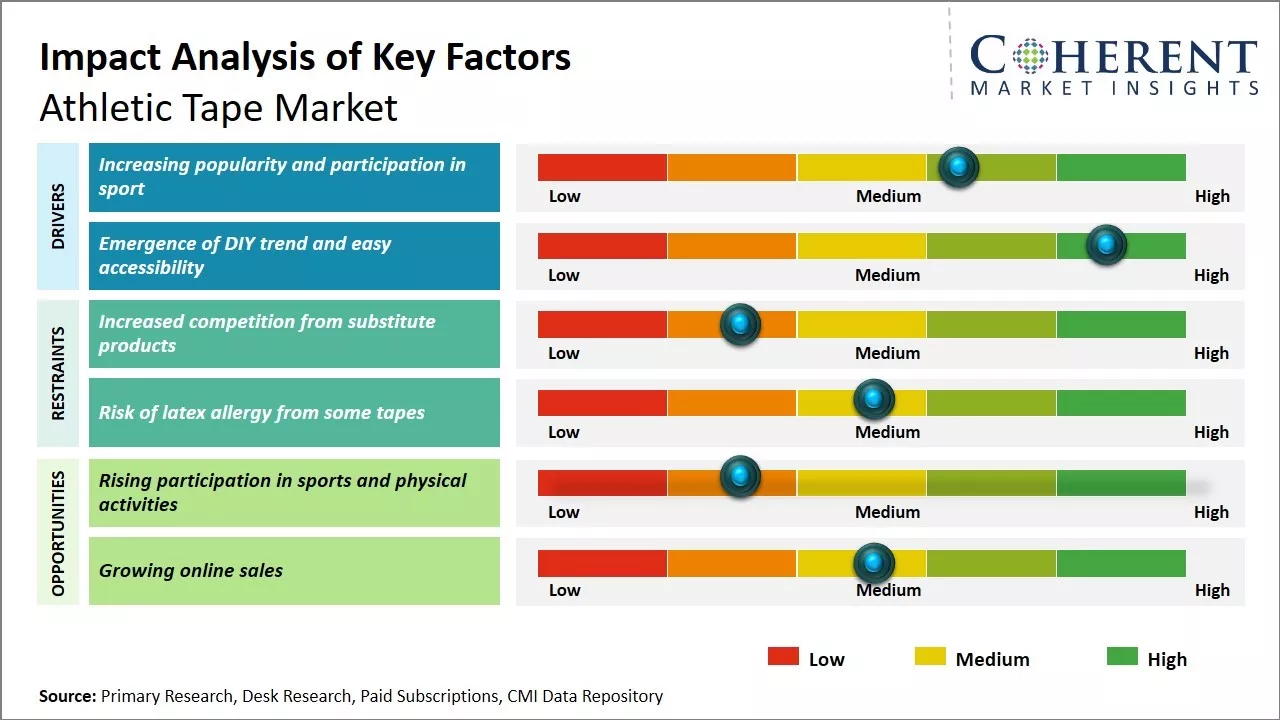
Discover market dynamics shaping the industry: Request sample copy
The athletic tape market is expected to witness positive growth over the forecast period. The growing popularity of sports and increased participation in sports and fitness activities worldwide is expected to drive the demand for athletic tape. Furthermore, the rising awareness regarding prevention and treatment of sports injuries is also fueling the adoption of athletic tape. Various innovations in terms of strengthening muscles and prevention of injuries are expected to further aid the growth of the athletic tape market. Increased spending on sports protective gear such as athletic tapes is also boosting the market. However, the availability of alternative options for muscle and joint support may hinder the growth of the athletic tape market during the forecast period.
Increasing popularity and participation in sport
With people becoming increasingly health conscious and fitness emerging as a lifestyle, participation in sports and outdoor activities has seen tremendous growth over the past decade. For instance according data by Government of Australia, in 2022, participation in sport and physical activity for social, psychological, and mental health reasons has increased over the past 5 years. More individuals have been taking up various recreational as well as professional sports as a way to remain active and indulge their competitive spirit. Activities ranging from traditional mainstream games like football, basketball, and tennis to niche sports like volleyball, badminton, swimming, etc. have gained widespread popularity. This growing involvement in sports has been a major factor propelling the demand for athletic tape which is used commonly for preventing injuries, providing support and assisting recovery. Sports physicians and trainers also recommend the use of tape for preventing reinjury of healed injuries. With the number of gym memberships and adventure sports enthusiasts on the rise, the consumption of tape to aid performance and for preventive protection during exercises and matches has surged significantly. Major international sporting leagues and competitions further inspire people to take up the involved sports which indirectly supports higher tape sales. Frequent product innovations catering to different sporting needs have also kept customers engaged with the category.
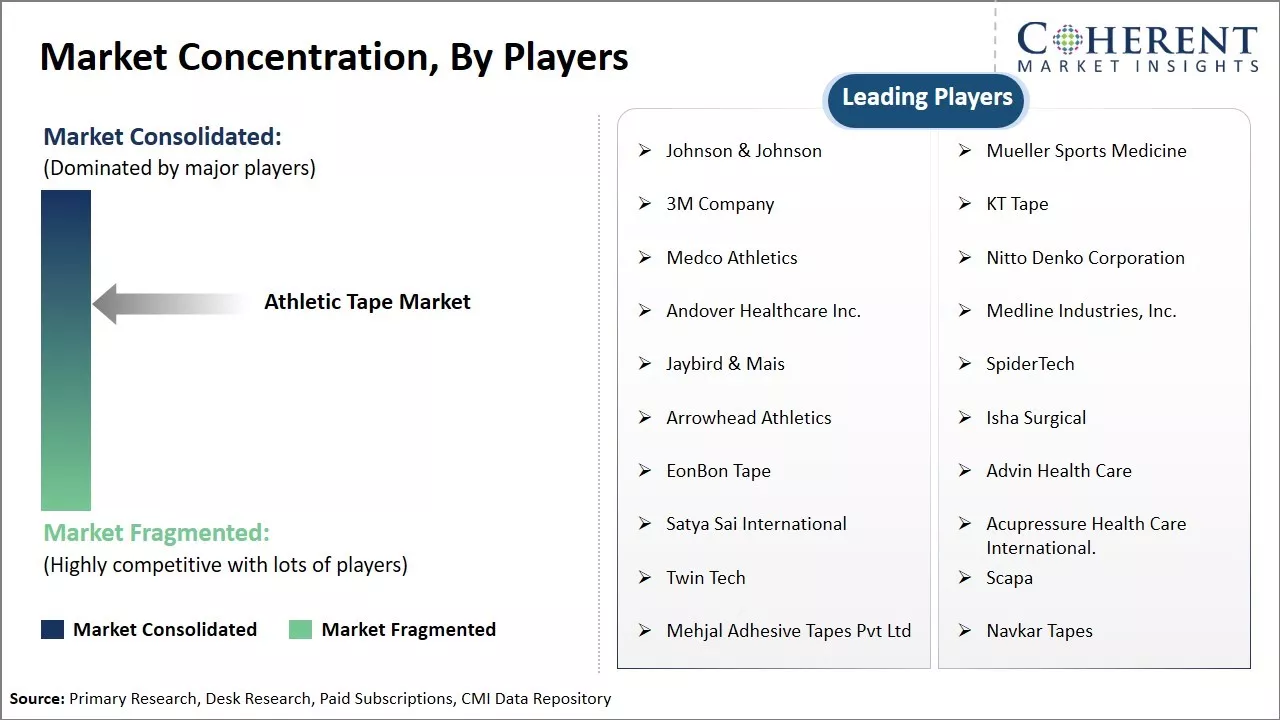
Get actionable strategies to beat competition: Request sample copy
Emergence of the DIY trend and easy accessibilityEarlier access to specialized sports gear including athletic tape used to be limited to professional athletes and high performance centers. However, nowadays consumers are exhibiting a strong DIY attitude and desire to self-care for minor injuries at home or during casual activities. The rising influence of social media where people widely share details of their fitness routines and lifestyle has made sports tapes popular even for everyday support and care. Brands have responded by formulating easy to use tape variants which do not require expert application. Likewise, e-commerce platforms offering tape products with just a few clicks have enabled hassle free shopping and boosted impulse purchases. Even general retail stores from pharmacies to supermarkets now shelve tapes for ankle, knee, etc. injuries. Together, the do-it-yourself movement as well as increased visibility and proximity of athletic tapes have brought the products to the mainstream attracting a varied set of recreative and casual users not just serious athletes. This expansion of target base has been a notable driver expanding the overall tape market size beyond the dedicated sports industry.
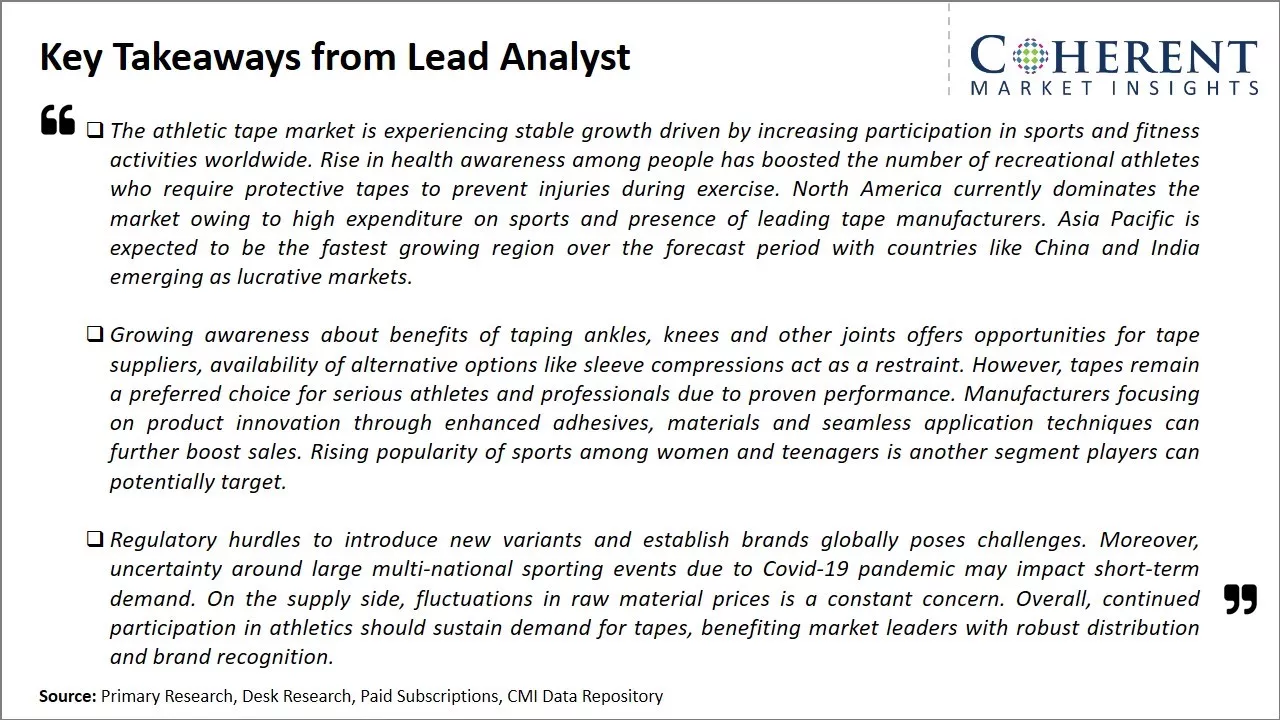
To learn more about this report, Request sample copy
Market Challenges: Increased competition from substitute productsThe global athletic tape market faces various challenges. Increased competition from substitute products, such as braces and sleeves, is threatening the market share of athletic tape. Moreover, stringent regulations pertaining to raw material sourcing and product quality are negatively impacting small manufacturers. Volatility in raw material prices owing to supply chain disruptions poses another challenge.
Market Opportunities: Rising participation in sports and physical activities
Rising participation in sports and physical activities worldwide is driving the need for the prevention and treatment of muscle injuries. Additionally, increased awareness about advantages of pre-exercise and post-exercise taping is fueling the sales of athletic tapes. Growing e-commerce channels are helping manufacturers to expand their reach among consumers. Key players can further explore opportunities in developing lightweight and breathable variants to strengthen their product portfolio.
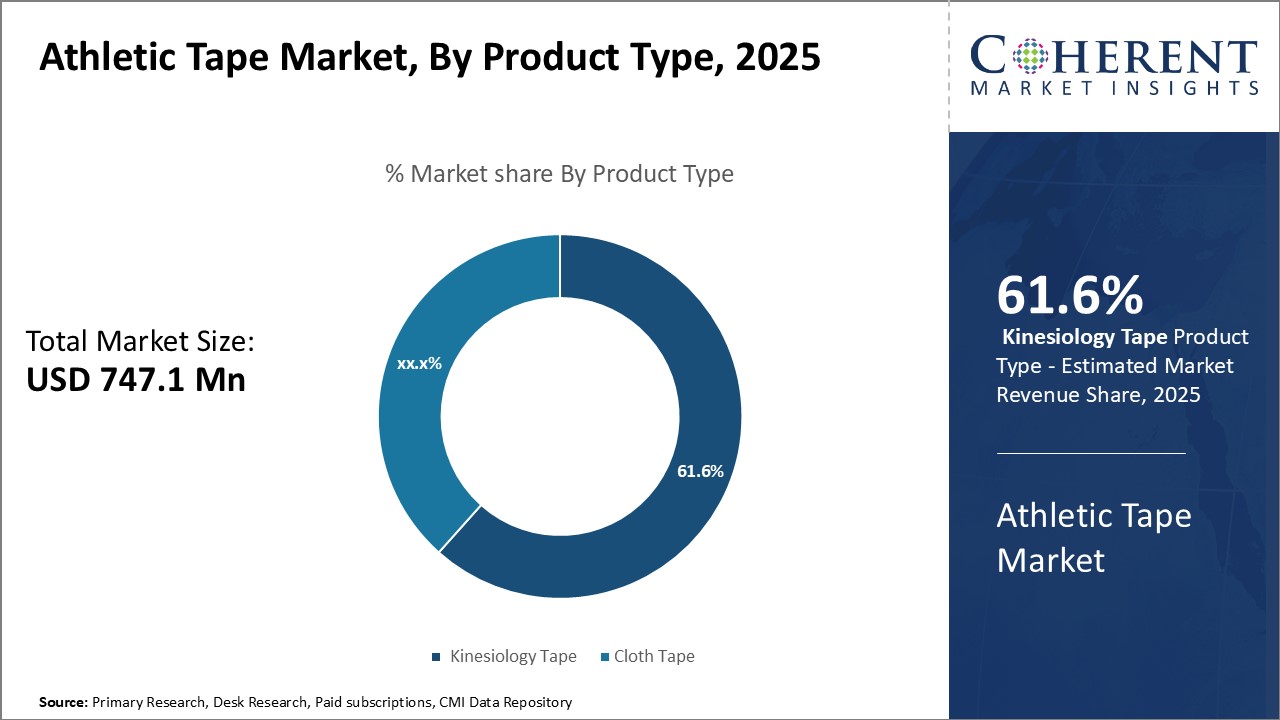
Discover high revenue pocket segments and roadmap to it: Request sample copy
Insights, By Product Type: The Convenience and Effectiveness of Kinesiology Tape Drives its PopularityIn terms of product type, kinesiology tape contributes 61.6% share of the market owing to its convenience and effectiveness compared to traditional cloth tape. Kinesiology tape is made of an elastic polymer material that can be stretched up to 140% of its original length. When applied to the skin, it creates a pulling effect on the muscles and fascia underneath. This pulling helps reduce pain by taking pressure off the nerves. The gentle elastic tension provided by kinesiology tape also improves blood circulation and lymphatic drainage. Due to its elastic nature, kinesiology tape moves comfortably with the skin and allows a greater range of motion compared to rigid cloth tape. As a result, athletes prefer using it for longer durations without any hindrance to their performance. Its lightweight and flexibility make kinesiology tape invisible under the jersey or uniform as well. The convenience of being able to wear it for days without having to replace it frequently drives its popularity significantly. Many athletes also choose kinesiology tape due to its effectiveness in supporting weak or injured muscles without being too restrictive. Its elastic tension provides just the right amount of support without immobilizing the joint entirely. This allows for faster recovery times. The ability to precisely place the tape for targeted muscle support has made it a preferred choice over general cloth tape methods.
Insights, By Application: Ankle Injuries Dominate Athletic Treatment Needs
In terms of application, ankle support contributes the 38.3% share of the market due to ankles being one of the most commonly injured body parts in all types of sports. With frequent jumping, landing, cutting, and lateral movements; ankles endure a lot of stress and are prone to sprains, strains, and ligament tears. Ankle braces and taping are essential for injury prevention as well as faster recovery for athletes. Due to the pivotal role ankles play in providing stability and generating power during various motions, even minor ankle injuries can take significant time to heal if not supported adequately. Taping or bracing helps reduce pain and swelling by providing compression to the injured area. It also restricts range of motion carefully in the initial phase to allow proper healing without disrupting the biomechanics of the ankle joint. Various ankle taping techniques involving different patterns of overlays and anchors ensure the joint and surrounding soft tissues receive uniform support in all directions. This prevents re-injury and allows athletes to return to play sooner with protected ankles. The effectiveness of ankle support through taping and bracing in reducing disabilities has made it the most common athletic tape application.
Insights, By End User: Hospitals Play a Vital Diagnostic and Rehabilitation Role
In terms of end user, hospitals and clinics contributes the 41.9% share of the market. While athletic tape is widely used by professional and amateur athletes for injury prevention and management, hospitals handle a significant volume for diagnostic and rehabilitation purposes as well. Physiotherapists and sports medicine specialists in hospitals employ various taping styles to analyze any deformities, muscular imbalances or compromised ranges of motion in patients presenting with chronic sprains, strains and orthopedic conditions. Specific taping patterns help isolate injured areas to pinpoint pain triggers during functional tests. Post-surgeries and accidents also involve lengthy taping of joints done in controlled settings at hospitals to protect healing tissues and slowly regain mobility. Controlled strength and flexibility exercises are then incorporated gradually under clinical guidance. Hospitals play a key role in customizing taping programs needed for a particular patient’s recovery timeline and precautions. Many amateur athletes also rely on hospitals for guidance from trained experts to rehabilitate injuries through taping before resuming sports activities. This ensures they avoid re-injury and make a full recovery. The diagnostic and meticulous rehabilitation aided by taping at hospitals has cemented their role as major end users.
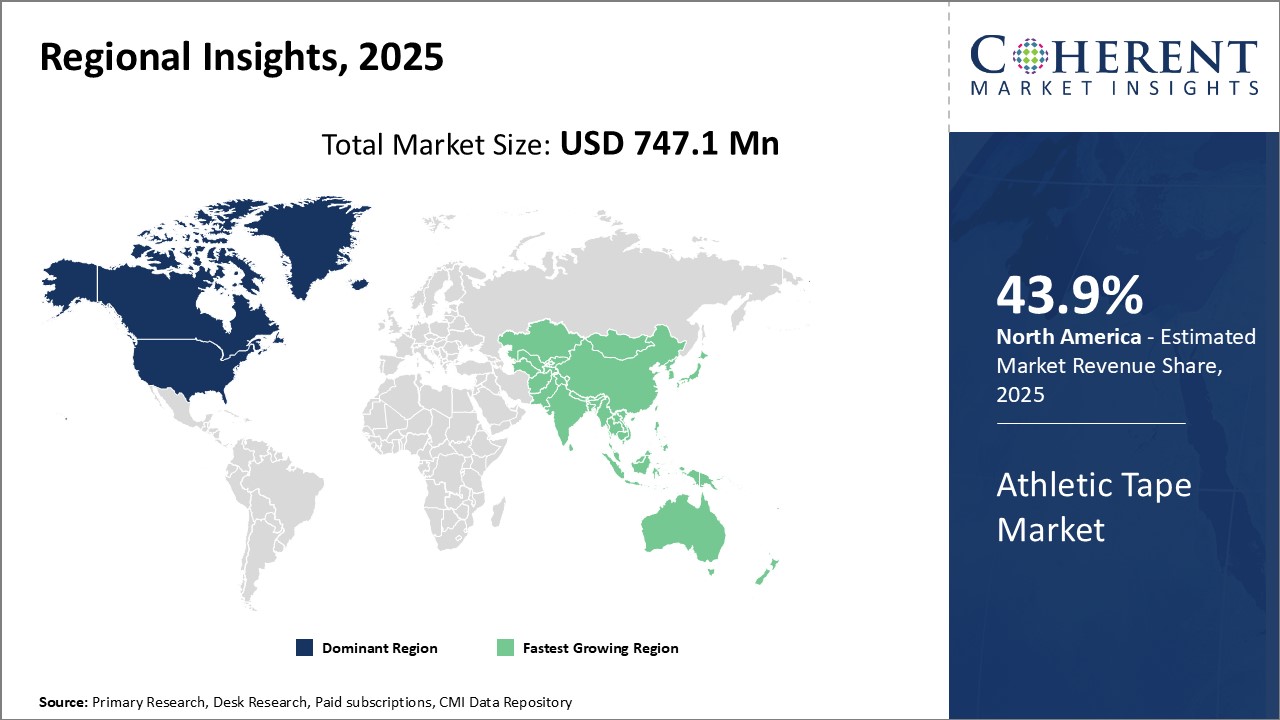
Need a Different Region or Segment? Customize now
North America has established itself as the dominant regional market for athletic tape with 43.9% share. With highly developed sports and fitness industries in the U.S. and Canada, the region accounts for the largest share of the global demand. American football is hugely popular in the U.S. and creates significant need for tape to wrap ankles, knees, and other joints prone to injury. Basketball is also widely played across North America, further driving tape requirements. Many major athletic tape manufacturers have their headquarters and production bases in North America, allowing them to effectively serve this core market. Leading brands like Johnson & Johnson, 3M and CCT Tapes have extensive distribution networks supplying all levels of sporting competitions and events. North American athletes have long relied on these established tape suppliers, trusting their products to support and protect joints during activity. Pricing in the region is competitive due to the large volumes and concentration of buyers.
Asia Pacific has emerged as the fastest growing regional market for athletic tape in recent years. Rapid economic development and rising standards of living across countries like China and India are supporting increased participation in sports. Along with established disciplines, new athletic programs and fitness cultures are taking hold. This is translating to the surging demand for athletic tape from both professional and casual athletes. Within Asia Pacific, China stands out as an especially dynamic athletic tape market. Its massive population and government initiatives to promote health and fitness have created a huge consumer base. International exposure through events like the Beijing Olympics accelerated grassroots popularity of sports in China. Both domestic and multinational tape brands have responded by ramping up manufacturing and sales/distribution networks in the country. While pricing in Asia Pacific remains lower than North America currently due to the developing nature of some markets, revenues are climbing quickly.
Athletic Tape Market Report Coverage
| Report Coverage | Details | ||
|---|---|---|---|
| Base Year: | 2024 | Market Size in 2025: | USD 747.1 Mn |
| Historical Data for: | 2020 To 2024 | Forecast Period: | 2025 To 2032 |
| Forecast Period 2025 to 2032 CAGR: | 8.9% | 2032 Value Projection: | USD 1,357.9 Mn |
| Geographies covered: |
|
||
| Segments covered: |
|
||
| Companies covered: |
SpiderTech, Arrowhead Athletics, Isha Surgical, EonBon Tape, Advin Health Care, Satya Sai International, Acupressure Health Care International., Twin Tech, Scapa , Mehjal Adhesive Tapes Pvt Ltd, and Navkar Tapes |
||
| Growth Drivers: |
|
||
| Restraints & Challenges: |
|
||
Uncover macros and micros vetted on 75+ parameters: Get instant access to report
*Definition: The athletic tape market consists of various tapes used by athletes, sports professionals, and fitness enthusiasts. Athletic tapes are used to provide support, stabilization, and compression to muscles, joints, and soft tissues. Some common types of athletic tapes include kinesiology tape, zinc oxide tape, electrical tape, and pre-wrap athletic tape. These tapes help in preventing injuries, supporting weak areas, and enhancing performance during high-intensity workouts and sports activities.
Share
Share
About Author
Yash Doshi is a Senior Management Consultant. He has 12+ years of experience in conducting research and handling consulting projects across verticals in APAC, EMEA, and the Americas.
He brings strong acumen in helping chemical companies navigate complex challenges and identify growth opportunities. He has deep expertise across the chemicals value chain, including commodity, specialty and fine chemicals, plastics and polymers, and petrochemicals. Yash is a sought-after speaker at industry conferences and contributes to various publications on topics related commodity, specialty and fine chemicals, plastics and polymers, and petrochemicals.
Missing comfort of reading report in your local language? Find your preferred language :
Transform your Strategy with Exclusive Trending Reports :
Frequently Asked Questions
Joining thousands of companies around the world committed to making the Excellent Business Solutions.
View All Our Clients
US Reciprocal Tax Impact Analysis On Athletic Tape Market
Stay updated on tariff changes with expert insights and timely information